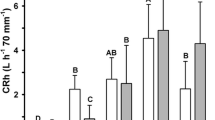Abstract
Seasonal variations in the growth, respiration and assimilation of the intertidal oyster Crassostrea virginica (Gmelin) of different sizes were determined. The instantaneous growth rates for intertidal oysters decreased with increasing size and with lower temperatures. Q10 values computed from instantaneous growth rates were approximately 2 during the warm growing season, but were higher in the colder months. Oxygen consumption increased with temperature and body size. A model was developed to predict oxygen consumption at any environmental temperature from 10° to 30°C for oysters ranging in weight from 0.1 to 100.0 g. Q10 values computed from oxygen-consumption rates decreased with increasing temperature and increasing body size. Intertidal oysters utilize a large proportion of their assimilated energy in growth.
Similar content being viewed by others
Literature Cited
Bayne, B. L.: Growth and delay of metamorphosis of the larvae of Mytilus edulis. Ophelia 2, 1–47 (1965).
Dame, R. F.: The ecological energies of growth, respiration and assimilation in the intertidal American oyster, Crassostrea virginica. Ph. D. Dissertation, 81 pp. University of South Carolina 1971.
Dame, R. F.: Allometric comparisons of some morphological characteristics of the American oyster. Fish. Bull. U.S. (1972). (In press).
Dehnel, P. A.: Rates of growth of gastropods as a function of latitude. Physiol. Zoöl. 28, 115–144 (1955).
—: Growth rates in latitudinally and vertically separated populations of Mytilus californianus. Biol. Bull. mar. biol. Lab., Woods Hole 110, 43–53 (1956).
Galtsoff, P. S.: The American oyster, Crassostrea virginica (Gmelin). Fishery Bull. Fish Wildl. Serv. U.S. 64, 1–480 (1964).
Giese, A. C.: Cell physiology, 671 pp. Philadelphia: Saunders 1968.
Gunter, G.: Comments on the shape, growth and quality of the American oyster. Science, N.Y. 88, 546–547 (1938).
Hemmingsen, A. M.: Energy metabolism as related to body size and respiratory surfaces, and its evolution. Rep. Steno meml Hosp. 9 (2), 1–110 (1960).
Hughes, R. N.: An energy budget for a tidal-flat population of the bivalve Scrobicularia plana. J. Anim. Ecol. 39, 357–381 (1970).
Ingle, R. M. and C. E. Dawson: Growth of the American oyster, Crassostrea virginica, in Florida waters. Bull. mar. Sci. Gulf Caribb. 2, 393–404 (1952).
Kuenzler, E. J.: Structure and energy flow of a mussel population in a Georgia salt marsh. Limnol. Oceanogr. 6, 191–204 (1961).
McHugh, J. L. and J. D. Andrews: Computation of oyster yields in Virginia. Proc. natn. Shellfish. Ass. 45, 217–239 (1955).
Morowitz, H. S.: Energy flow in biology, 179 pp. New York: Academic Press 1968.
Phillipson, J.: Ecological energetics, 57 pp. London: Arnold 1966.
Rao, K. P. and T. H. Bullock: Q10 as a function of size and habitat temperature in poikilotherms. Am. Nat. 88, 33–44 (1954).
Ricker, W. E.: Handbook of computations for biological statistics of fish populations. Bull. Fish. Res. Bd Can. 119, 1–300 (1958).
—: Methods for assessment of fish production in fresh waters, IBP Handbook No. 3. 313 pp. Oxford: Blackwell's 1968.
Smalley, A. E.: Energy flow of a salt marsh grasshopper population. Ecology 41, 672–677 (1960).
Steel, R. G. D. and J. H. Torrie: Principles and procedures of statistics, 481 pp. New York: McGraw-Hill 1960.
Strickland, J. D. H. and T. R. Parsons: A practical handbook of sea water analysis. Bull. Fish. Res. Bd Can. 167, 1–311 (1965).
Vernberg, F. J. and W. B. Vernberg: The animal and the environment, 398 pp. New York: Holt, Reinhart & Winston 1970.
Wiegert, R. G.: Thermodynamic considerations in animal nutrition. Am. Zool. 8, 71–81 (1968).
Zeuthen, E.: Oxygen uptake as related to body size in organisms. Q. Rev. Biol. 28, 1–12 (1953).
Author information
Authors and Affiliations
Additional information
Communicated by J. Bunt, Miami
Supported by a Belle W. Baruch Fellowship in Marine Ecology.
Rights and permissions
About this article
Cite this article
Dame, R.F. The ecological energies of growth, respiration and assimilation in the intertidal American oyster Crassostrea virginica . Marine Biology 17, 243–250 (1972). https://doi.org/10.1007/BF00366299
Accepted:
Issue Date:
DOI: https://doi.org/10.1007/BF00366299




